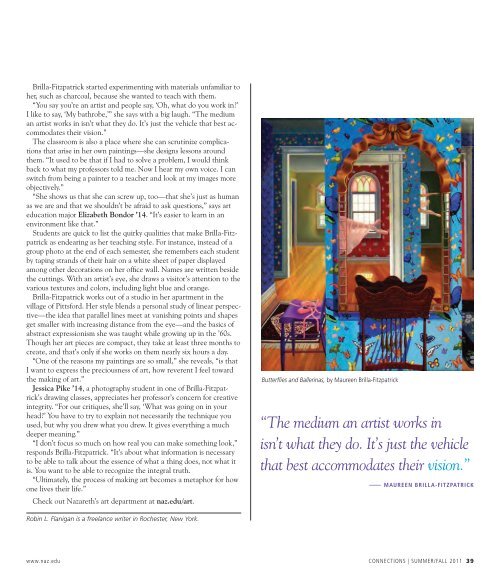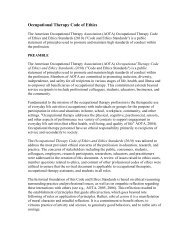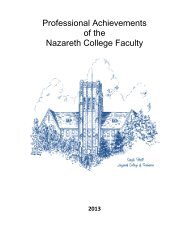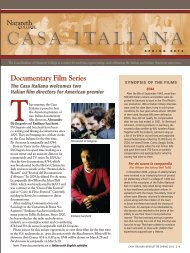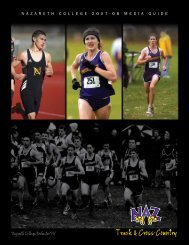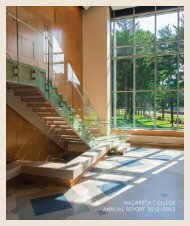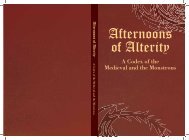SummEr/FAll 2011 - Nazareth College
SummEr/FAll 2011 - Nazareth College
SummEr/FAll 2011 - Nazareth College
You also want an ePaper? Increase the reach of your titles
YUMPU automatically turns print PDFs into web optimized ePapers that Google loves.
Brilla-Fitzpatrick started experimenting with materials unfamiliar to<br />
her, such as charcoal, because she wanted to teach with them.<br />
“You say you’re an artist and people say, ‘Oh, what do you work in?’<br />
I like to say, ‘My bathrobe,’” she says with a big laugh. “The medium<br />
an artist works in isn’t what they do. It’s just the vehicle that best accommodates<br />
their vision.”<br />
The classroom is also a place where she can scrutinize complications<br />
that arise in her own paintings—she designs lessons around<br />
them. “It used to be that if I had to solve a problem, I would think<br />
back to what my professors told me. Now I hear my own voice. I can<br />
switch from being a painter to a teacher and look at my images more<br />
objectively.”<br />
“She shows us that she can screw up, too—that she’s just as human<br />
as we are and that we shouldn’t be afraid to ask questions,” says art<br />
education major Elizabeth Bondor ’14. “It’s easier to learn in an<br />
environment like that.”<br />
Students are quick to list the quirky qualities that make Brilla-Fitzpatrick<br />
as endearing as her teaching style. For instance, instead of a<br />
group photo at the end of each semester, she remembers each student<br />
by taping strands of their hair on a white sheet of paper displayed<br />
among other decorations on her office wall. Names are written beside<br />
the cuttings. With an artist’s eye, she draws a visitor’s attention to the<br />
various textures and colors, including light blue and orange.<br />
Brilla-Fitzpatrick works out of a studio in her apartment in the<br />
village of Pittsford. Her style blends a personal study of linear perspective—the<br />
idea that parallel lines meet at vanishing points and shapes<br />
get smaller with increasing distance from the eye—and the basics of<br />
abstract expressionism she was taught while growing up in the ’60s.<br />
Though her art pieces are compact, they take at least three months to<br />
create, and that’s only if she works on them nearly six hours a day.<br />
“One of the reasons my paintings are so small,” she reveals, “is that<br />
I want to express the preciousness of art, how reverent I feel toward<br />
the making of art.”<br />
Jessica Pike ’14, a photography student in one of Brilla-Fitzpatrick’s<br />
drawing classes, appreciates her professor’s concern for creative<br />
integrity. “For our critiques, she’ll say, ‘What was going on in your<br />
head?’ You have to try to explain not necessarily the technique you<br />
used, but why you drew what you drew. It gives everything a much<br />
deeper meaning.”<br />
“I don’t focus so much on how real you can make something look,”<br />
responds Brilla-Fitzpatrick. “It’s about what information is necessary<br />
to be able to talk about the essence of what a thing does, not what it<br />
is. You want to be able to recognize the integral truth.<br />
“Ultimately, the process of making art becomes a metaphor for how<br />
one lives their life.”<br />
Check out <strong>Nazareth</strong>’s art department at naz.edu/art.<br />
Butterflies and Ballerinas, by Maureen Brilla-Fitzpatrick<br />
“The medium an artist works in<br />
isn’t what they do. It’s just the vehicle<br />
that best accommodates their vision.”<br />
— MAUREEN Brilla-Fitzpatrick<br />
Robin L. Flanigan is a freelance writer in Rochester, New York.<br />
www.naz.edu CONNECTIONS | Summer/Fall <strong>2011</strong> 39


